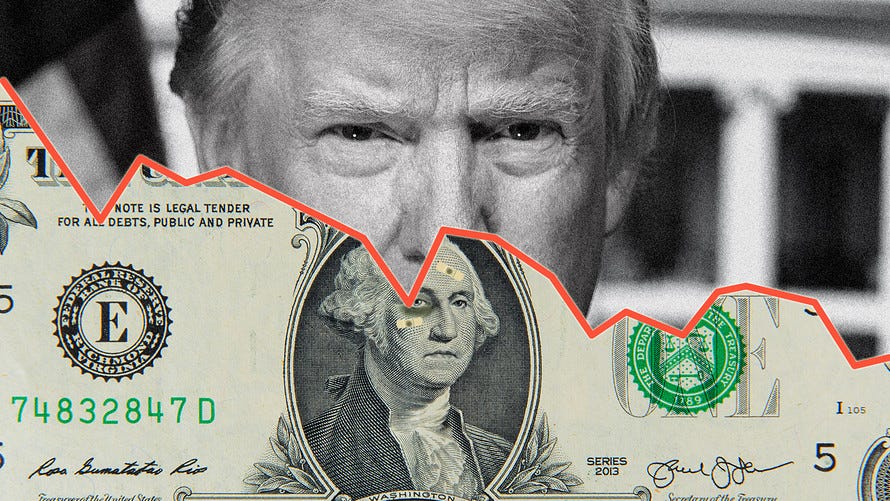Cracks in the Empire: Dollar Hegemony Under Strain
Trump’s tariff wars have accelerated the erosion of dollar hegemony, exposing the structural contradictions of America’s financial empire in a multipolar world.
The Trump administration's economic war on the world has intensified the contradictions of the American economic empire, a system long sustained by what former French President Valéry Giscard d'Estaing famously called the United States' "exorbitant privilege": the unique role of the US dollar in the global economy. Or as some might put it more bluntly: America gets to print money while others have to earn it.
Origins of Dollar Hegemony
At the end of World War II, the United States emerged as the dominant global economic power. Thanks to unmatched industrial capacity, vast natural resources, and the physical devastation of Europe and Asia, the U.S. accumulated a record gold reserve, having exported consumer goods, capital, and military goods across the globe.
However, by the late 1960s, three structural forces began to erode this gold-backed dominance:
Cold War Military Spending: From the Korean War to the Marshall Plan and Vietnam, massive overseas spending depleted U.S. reserves.
Domestic Keynesianism: Under Kennedy and Johnson, increased public spending expanded the money supply even as gold reserves dwindled.
Industrial Competition: Export-led growth in Japan, West Germany, and later France and South Korea reduced the U.S.'s trade surplus.
By the late 1960s, the U.S. faced a major dilemma: how to supply dollars globally while constrained by declining gold reserves under the Bretton Woods system.
Nixon and the Dollar's Reinvention
On August 15, 1971, President Richard Nixon announced the suspension of dollar convertibility into gold, effectively ending the gold standard. Though pitched as temporary, this shift laid the foundation for a new global order of floating exchange rates and unrestrained dollar creation. Nixon didn’t just go to China—he quietly told the world: “We’re printing now, and you’re going to like it.”
Freed from gold constraints, the U.S. enabled a financial revolution: massive credit expansion, deregulated capital flows, and the rise of finance as a dominant force in the American economy. As industrial capital moved offshore—particularly to East Asia, Central America, and Eastern Europe—the U.S. became increasingly reliant on a bifurcated service sector. America imported goods made abroad while exporting debt instruments—treasuries, bonds, and equities—to the world.
This financial architecture entrenched the dollar as the global reserve currency. Its role as a safe asset allowed the U.S. to borrow cheaply, even as its trade and fiscal deficits widened.
Contradictions of Dollar Dominance
Yet this privilege came at a cost. A strong dollar hurt U.S. exports, hollowed out manufacturing, and deepened service sector inequality. At the same time, government borrowing exploded, driven by tax cuts for the wealthy and military expenditures, raising sustainability concerns.
Today, public debt and interest payments are surging, while the capacity to raise revenue through taxation remains politically constrained. The Trump administration’s aggressive tariff regime—mirroring Nixon's 1971 policy—has only added volatility.
In April 2025, following market turmoil, the Trump administration announced a partial 90-day pause on tariffs. But the dollar, traditionally a safe haven, declined sharply. The DXY index dropped 2.8% in one week, extending its year-to-date loss to 8.2%, and fell further against haven currencies like the Swiss franc and Japanese yen.
A weaker dollar carries contradictory implications: it could boost exports and reshore industry, but also risks capital flight, higher borrowing costs, and weakened investor confidence. Think of it like a diet that works but makes you so grumpy that no one wants to hang out with you.
The Specter of Decline
Two key questions now dominate global investor discussions:
How much further can the dollar fall? Foreigners hold $19 trillion in U.S. equities, $7 trillion in Treasuries, and $5 trillion in corporate bonds. Even modest selloffs could exert sustained downward pressure.
Could this erode the dollar's hegemonic role?
While the U.S. comprises only 25% of global GDP, 57% of official foreign currency reserves remain in dollars. More than half of global exports are invoiced in dollars; 60% of international loans and 70% of bond issuances are dollar-denominated; and 88% of forex transactions involve the dollar. Over $1 trillion in U.S. cash circulates abroad.
This global dependence creates structural demand for dollar assets, but also amplifies systemic risks when confidence falters.
Limits of Alternatives
Despite calls for de-dollarization, viable alternatives are few:
Euro: Constrained by political fragmentation and weak fiscal unity.
Chinese Renminbi: Lacks full convertibility and is tightly managed.
Japanese Yen & Swiss Franc: Too small in scale.
Yet momentum is growing elsewhere. BRICS countries are advancing alternatives, including a proposed BRICS common currency, and increased settlement in local currencies for trade. Russia and China have ramped up energy transactions in yuan, while India and UAE have begun settling trade in rupees and dirhams.
Meanwhile, central banks in emerging markets are diversifying reserves, increasing holdings in gold and non-dollar assets. SWIFT alternatives like China’s CIPS and Russia’s SPFS are also gaining ground. The architecture is forming, if not yet storming.
Conclusion: A Hegemony Under Pressure
The dollar's role is not disappearing overnight. But under Trump’s erratic policies, compounded by fiscal imbalances, geopolitical friction, and growing dissatisfaction among U.S. allies and adversaries alike, its dominance is no longer unquestioned.
The world is not yet de-dollarized. But it is no longer unipolar.




